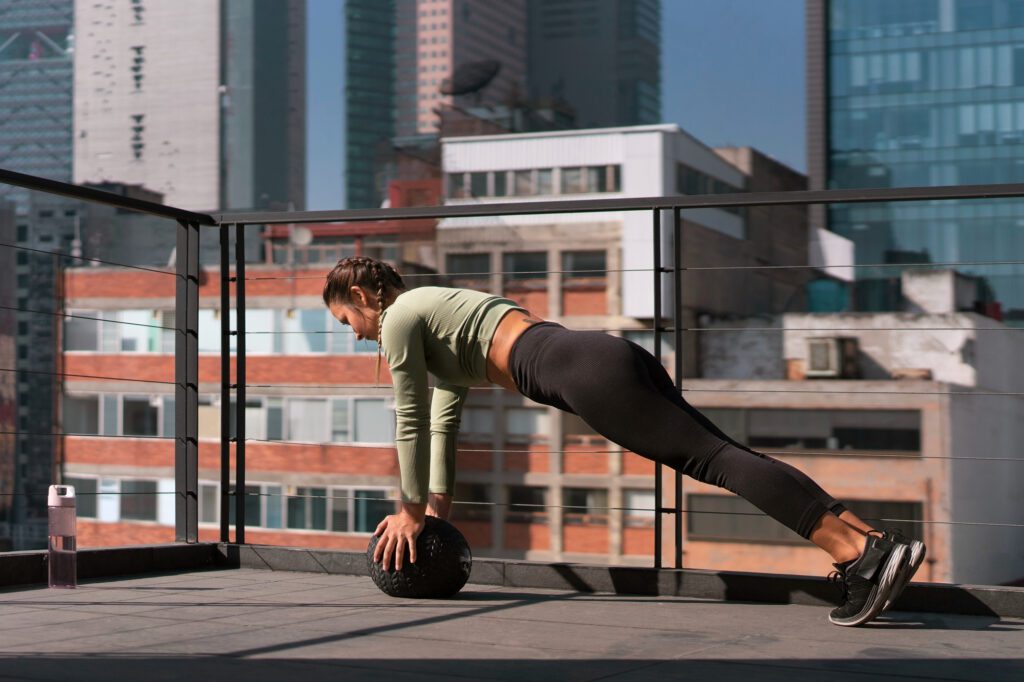Imagine you’re training for a big race, but you also want to lift heavy weights like a champ and master new skills, all without spending hours at the gym.
Sounds like a tough challenge, right? Well, it doesn’t have to be.
With a well-planned 4-day split routine, you can balance strength, endurance, and skill in just four days a week.
This approach is perfect for hybrid athletes who want to excel in various fitness aspects without feeling overwhelmed.
So, shall we get into the nitty-gritty of a “Hybrid Athlete 4-day split?”
Hybrid Athlete 4-Day Split
A 4-day split for a hybrid athlete focuses on balancing strength, endurance, and skill. Here’s a sample routine:
Day 1: Strength Training – Upper Body

1. Bench Press
- Sets/Reps: 4 sets of 6-8 reps
- Purpose: Builds chest strength and size, enhancing pushing power essential for various sports and activities.
- Tip: Maintain a controlled motion and avoid bouncing the bar off your chest to maximize muscle engagement.
2. Pull-Ups
- Sets/Reps: 4 sets of 6-8 reps
- Purpose: Develops upper back, biceps, and forearms strength, crucial for pulling motions and overall upper body strength.
- Tip: Use a full range of motion and aim for slow, controlled movements to increase muscle activation for your pull day.
3. Overhead Press
- Sets/Reps: 4 sets of 6-8 reps
- Purpose: Targets the shoulders and triceps, improving overhead strength and stability, vital for pushing and overhead movements.
- Tip: Keep your core tight and avoid excessive arching of your lower back.
4. Rows
- Sets/Reps: 4 sets of 8-10 reps
- Purpose: Strengthens the upper back and lats, balancing the pushing exercises with pulling movements for overall upper body strength.
- Tip: Focus on squeezing the shoulder blades together to fully engage the back muscles.
5. Accessory Work
- Bicep Curls: 3 sets of 10-12 reps
- Tricep Extensions: 3 sets of 10-12 reps
- Purpose: Isolates and strengthens the arm muscles to complement the compound upper body exercises.
- Tip: Use proper form and controlled movements to avoid strain and maximize effectiveness.
Day 2: Conditioning & Skills

1. HIIT Workout
- Duration: 20-30 minutes
- Examples: Sprints, burpees, kettlebell swings
- Purpose: Enhances cardiovascular fitness, boosts metabolism, and improves overall conditioning.
- Tip: Maintain high intensity during work intervals and use brief, active recovery periods to maximize endurance benefits.
2. Skill Work
- Duration: 30 minutes
- Examples: Agility drills (e.g., ladder drills), mobility exercises (e.g., dynamic stretching)
- Purpose: Refines specific athletic skills, enhances coordination, and increases flexibility and range of motion.
- Tip: Focus on technique and consistency to improve skill execution and prevent injuries.
Day 3: Strength Training – Lower Body

1. Squats
- Sets/Reps: 4 sets of 6-8 reps
- Purpose: Builds lower body strength, targeting quads, hamstrings, and glutes, essential for explosive power and overall lower body development.
- Tip: Ensure proper depth and form to maximize muscle engagement and reduce the risk of injury.
2. Deadlifts
- Sets/Reps: 4 sets of 6-8 reps
- Purpose: Develops posterior chain strength, including hamstrings, glutes, and lower back, improving overall strength and power.
- Tip: Keep the bar close to your body and engage your core throughout the movement to maintain proper form.
3. Lunges
- Sets/Reps: 3 sets of 10-12 reps per leg
- Purpose: Enhances leg strength, balance, and coordination, focusing on quads, hamstrings, and glutes.
- Tip: Keep your torso upright and step forward with control to maximize effectiveness and prevent injury.
4. Leg Press
- Sets/Reps: 3 sets of 8-10 reps
- Purpose: Targets the quadriceps, hamstrings, and glutes, providing a different angle of resistance compared to squats for the leg day.
- Tip: Adjust the seat and foot position to ensure proper alignment and avoid overloading the knees.
5. Accessory Work
- Calf Raises: 3 sets of 10-12 reps
- Hamstring Curls: 3 sets of 10-12 reps
- Purpose: Strengthens the calf muscles and hamstrings, complementing the main lower body exercises for balanced development.
- Tip: Perform each exercise with controlled movements to fully engage the target muscles.
Day 4: Endurance & Recovery

1. Long-Distance Run
- Duration: 45-60 minutes at a moderate pace
- Purpose: Enhances cardiovascular endurance and aerobic capacity, contributing to overall stamina and fitness.
- Tip: Maintain a steady pace that challenges you without causing excessive fatigue.
2. Active Recovery
- Duration: 20-30 minutes
- Examples: Stretching, yoga, light swimming
- Purpose: Promotes muscle recovery, flexibility, and relaxation, helping to reduce soreness and improve mobility.
- Tip: Focus on gentle movements and stretches to aid in muscle recovery and prevent stiffness.
The Importance Of Split In A Workout Routine
Splits in a workout routine are crucial for several reasons:
1. Focused Training
Splitting workouts by muscle groups or training goals (e.g., strength, endurance) allows for more focused and effective training.
It enables you to target specific areas with greater intensity and detail, which can lead to better overall progress.
2. Recovery
A well-designed split ensures that different muscle groups have adequate time to recover between sessions.
For instance, if you train your upper body one day, your lower body gets a break, reducing the risk of overtraining and injuries.
3. Increased Training Volume
Splits allow you to increase the total volume of your training without extending your workout sessions excessively.
By focusing on specific muscle groups or types of training each day, you can fit in more hybrid training exercises and sets per session.
4. Variety
Splitting workouts can add variety to your routine, which helps keep training interesting and engaging.
It also allows you to incorporate different types of exercises and training modalities, which can enhance overall fitness and prevent plateaus.
5. Improved Performance
By dedicating specific days to different types of workouts, you can improve your performance in each area.
For example, a split routine can help you excel in both strength and conditioning by giving each focus its own dedicated time.
6. Efficiency
Splits help optimize workout efficiency by concentrating on particular goals or muscle groups per session.
This focused approach often results in more effective and time-efficient workouts, especially if you have limited time to train.
7. Balanced Development
A well-structured split ensures that all muscle groups are worked evenly and prevents imbalances.
This balanced approach promotes overall muscular development and reduces the risk of injuries caused by muscle imbalances.
Conclusion
So this is your hybrid athlete 4-day split routine that makes balancing strength, endurance, and skill not just possible but fun and effective.
By focusing on different areas each day, you can improve your overall fitness without burning out.
If you’re gearing up for a race, aiming to build muscle, or just looking to enhance your skills, this routine will help you achieve your goals while keeping your workouts exciting and manageable.
Ready to give it a try?



